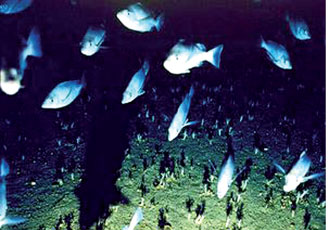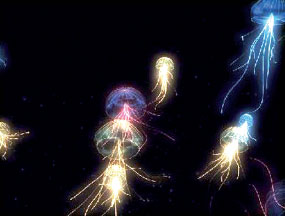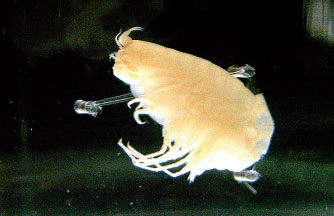Teaming with life
by Indunil Thenuwara
 When I was around four/five
years old, I used to think that the Mariana Trench must be like our
well, a perfect circular hole going deep, deep down (believe me, our
well was DEEP). Although the exact proportions and dimensions eluded me,
the deepest point on Earth fascinated me to the extent of being an
obsession. When I was around four/five
years old, I used to think that the Mariana Trench must be like our
well, a perfect circular hole going deep, deep down (believe me, our
well was DEEP). Although the exact proportions and dimensions eluded me,
the deepest point on Earth fascinated me to the extent of being an
obsession.
Thoughts of the dark, bottomless pit and escaping its cold clutches,
if I ever happen to fall into it due to some unforseen reason, took up
considerable time and space in my childhood mind. By the time I started
schooling, I had resolved never to swim, sail or fly above this most
dangerous point on Earth lest I accidentally “fall” in.
Of course, later years taught me that the Mariana Trench was quite
different to what I had thought it to be. That, in fact, it is much,
much deeper than I had thought, that there would have been no hope of
escape had I fallen into it as the extreme pressure would have turned me
to pulp, that there’s life in it despite the depth, darkness, pressure
and lack of air, and that it had been accessed and explored by humans,
with a little help from technology!
The mysteries of this spot in the Pacific Ocean east of the
Philippines were brought out into the open once again, through a touch
of fiction, by Dan Brown’s bestselling novel of 2001, Deception Point.
In fact, Brown provides such a vivid, ‘in depth’ and accurate
description of the Mariana Trench that the novel could almost be
considered as a factual account of the pit. However, the details have
been blended into the story in such a way that the reader never feels
bored or tired.
For instance, did you know that there is life in the Mariana Trench
(as described in great detail in the book)? The lack of light, oxygen
and nutrients and the extreme pressure would not have sustained life in
these depths, one would think, but this is far from true.
Life is very much evident in the Trench, even at its deepest point,
Challenger Deep, which is 11km (36,201 ft) below sea level and found at
the southern end of the Trench. In fact, the abundance of life in these
depths has surprised scientists.
Beside the single-celled life forms which comprise the majority of
its population, the Trench is also home to certain varieties of fish,
shrimp, scale worms and sea cucumber.
 Soil samples retrieved from the ocean floor by remotely-operated
submersibles such as Kaiko and Alvin had revealed soft-walled,
single-celled microorganisms/microbes which resembled earlier forms of
life, and were different to life as we know it; ex, animals, plants and
fungi. Soil samples retrieved from the ocean floor by remotely-operated
submersibles such as Kaiko and Alvin had revealed soft-walled,
single-celled microorganisms/microbes which resembled earlier forms of
life, and were different to life as we know it; ex, animals, plants and
fungi.
These were life forms which cannot be observed with the naked eye. A
gram of dried mud from the ocean floor had revealed about a million
bacteria.
Single-celled protists that construct shells, known as foraminifera,
inhabit the ocean floor. Over 4,000 forms of foraminifera have been
discovered so far; some of them live on the bottom of the ocean, while
others occupy the upper 300ft of the ocean; some live in fresh water
while some live on land. Over 432 forms of foraminifera have been found
in Challenger Deep.
Life not only exists in the most extreme environments, it has adapted
well to those conditions too over millions of years.
It has also been observed that the foraminifera in these depths are
soft-walled and tube-shaped as hard-shelled species cannot survive the
pressure at such depths. Eighty five percent of the foraminifera found
in Challenger Deep were of the above variety while the rest were
spherical or clumped together forms.
The lack of nutrients or photosynthesis (light penetrates only the
upper 100-200 metres of the ocean) in the environment doesn’t hamper
them as their own waste pellets are used as a source of nutrition.
Further, it’s believed that their survival is aided by the lack of
predators.
 Some microbes are also known as barotolerant meaning they can
tolerate extreme pressure, while some are barophilic meaning they depend
on extreme pressure for their survival. The latter comprise the majority
in the Mariana Trench. They are also said to be psychrophilic - loving
the cold. Some microbes are also known as barotolerant meaning they can
tolerate extreme pressure, while some are barophilic meaning they depend
on extreme pressure for their survival. The latter comprise the majority
in the Mariana Trench. They are also said to be psychrophilic - loving
the cold.
Though invertebrates comprise the most part of life in the Mariana
Trench, fish like anglerfish which use bioluminescent light to catch
prey, and viperfish also inhabit the ocean bottom. These fish are
believed to consume the microorganisms which feed on the bacteria.
This proves that life thrives even in the most inhospitable terrain,
the deepest recesses in the ocean. Life often finds a way, even in the
face of the toughest adversity. But the Mariana Trench is yet to give up
all its secrets. Dig deep and ye shall discover!
|

